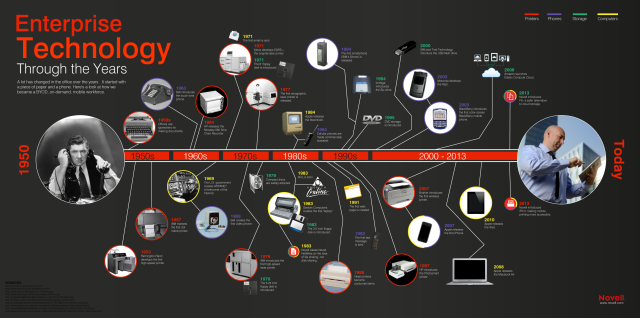The Evolution of Enterprise Software Selection
Back in the 80’s, when PC DOS-based (later Windows) Enterprise software sales began to increase, individual departments started to exert some control over the selection of applications. Previously, software decisions were largely left to IT and finance, with some level of input by end users and departmental stake holders.
Prior to the advent of the PC, Enterprise software was primarily mainframe based, and therefore very expensive to operate and maintain. Companies typically supported only 1 computer platform, so decision #1 was to find software that ran in that environment. The PC changed all that. In the early days micro-computer software was initially written for a single PC and user, as networking of PC’s was in its infancy (remember Novell Netware?). Software was also primarily meant for a single-function – such as for bookkeeping, shop-floor control or time tracking.
About that Novell Netware; Novell took the PC to the next critical level, permitting a single application to be shared by multiple users simultaneously. Software developers took advantage of the networking platform and began writing even more powerful and feature-rich solutions. Software evolved from single-purpose to systems designed to run entire departments and even entire businesses (think ERP).
Then came Windows, Windows NT (Microsoft’s answer to Novell), client-server, and eventually the Web. These new innovations spawned the growth of mainframe-class Enterprise software running in a much lower cost environment. Now, to some degree, departments were freed from IT-heavy decision influence and could own the selection process, focusing on the systems that best fit their business requirements rather than just one that IT could readily support.
Mirroring this evolution in software selection was the sales tactics vendors used to sell their products. First came the Feature-Function-Benefit (FFP) approach. Sales folks would attempt to wow newly empowered end users with bells and whistles. “Here is our feature, here is what it will do for you, and here is the benefit you will realize from it”. In other words, FFP attempted to create need, whether or not the department really needed it. Since end-users were new to this process, FFP often worked successfully to impress decision influencers.
As users began to wise up, a new sales strategy was developed called Solution Selling. In this approach, sales people would ask questions in the hope of finding a real need (pain point) the department actually had. Then they would match features to that need. Solution Selling is considered the most professional sales strategy, since a strong focus is placed on departmental needs rather than feature glitz.
A fresh new set of IT concerns has now taken the software selection process full circle today, with IT again heavily involved due to new security concerns. Security issues are proliferating because of the open nature of the Internet – and virtually all modern enterprise applications are now web-based. It is no small coincidence that ever-popular cloud computing (aka shared resources over the Internet) has grown in lockstep with the almost-daily news stories about major computer breaches, both in the private and public business sectors.
With IT back at the center of software selection, there is no room for FFB, and even little interest in Solution Selling. IT is not interested in sales pitches of any kind – they primarily want to understand the security capabilities of the vendor’s systems, and if those capabilities meet and exceed the organization’s stringent requirements.
Yes, department heads must clearly define their business needs and seek out the best-fit solutions, but more often these days a few desired bells and whistles may be sacrificed in the name of security, particularly when HIPAA, PII, PHI, and PCI data confidentiality is at stake.
HR is especially vulnerable to system breaches, and must work closely with IT during the selection process. Back in the client-server days, system security was much less of a concern because system communications was generally limited to internal networks and private data lines (for remote employees). Glitzy features often won the day with users. Today, with Internet based systems that can never be 100% secure, it’s all about minimizing the potential for breaches, and not FFB.
How will the next generation of computing impact the software selection process? Only time will tell.
Related articles
Image Source: Novell








